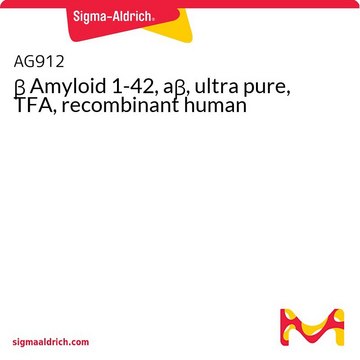SCP0048
Amyloid β 42-1 reverse human
≥95% (HPLC)
Iniciar sesiónpara Ver la Fijación de precios por contrato y de la organización
About This Item
Fórmula empírica (notación de Hill):
C203H311N55O60S1
Peso molecular:
4514.04
Código UNSPSC:
12352200
NACRES:
NA.32
Productos recomendados
Análisis
≥95% (HPLC)
formulario
lyophilized
composición
Peptide Content, ≥75%
condiciones de almacenamiento
protect from light
temp. de almacenamiento
−20°C
Amino Acid Sequence
Ala-Ile-Val-Val-Gly-Gly-Val-Met-Leu-Gly-Ile-Ile-Ala-Gly-Lys-Asn-Ser-Gly-Val-Asp-Glu-Ala-Phe-Phe-Val-Leu-Lys-Gln-His-His-Val-Glu-Tyr-Gly-Ser-Asp-His-Arg-Phe-Glu-Ala-Asp
Aplicación
Amyloid β (Aβ) refers to peptides derived from Amyloid precursor protein that vary in length from 36-43 amino acids. Aβ(s) peptides, their peptide fragments and mutated fragments are used to study a wide range of metabolic and regulatory functions including activation of kinases, regulation of cholesterol transport, function as a transcription factor, and regulators of inflammation. Aβ(s) peptides and their peptide fragments are also used to study oxidative stress, metal binding and mechanisms of protein cross-linking in the context of diseases such as Alzheimer′s disease and neurodegeneration.
Código de clase de almacenamiento
11 - Combustible Solids
Clase de riesgo para el agua (WGK)
WGK 3
Punto de inflamabilidad (°F)
Not applicable
Punto de inflamabilidad (°C)
Not applicable
Certificados de análisis (COA)
Busque Certificados de análisis (COA) introduciendo el número de lote del producto. Los números de lote se encuentran en la etiqueta del producto después de las palabras «Lot» o «Batch»
¿Ya tiene este producto?
Encuentre la documentación para los productos que ha comprado recientemente en la Biblioteca de documentos.
Los clientes también vieron
Kodeeswaran Parameshwaran et al.
Synapse (New York, N.Y.), 61(6), 367-374 (2007-03-21)
The brains of Alzheimer's disease (AD) patients have large numbers of plaques that contain amyloid beta (Abeta) peptides which are believed to play a pivotal role in AD pathology. Several lines of evidence have established the inhibitory role of Abeta
S M Yatin et al.
Neurobiology of aging, 20(3), 325-330 (1999-12-10)
The amyloid beta-peptide (A beta)-associated free radical oxidative stress model for neuronal death in Alzheimer's disease (AD) brain predicts that neuronal protein oxidation is a consequence of A beta-associated free radicals [8]. In this study we have used both in
Lin Wang et al.
Journal of Alzheimer's disease : JAD, 64(3), 957-971 (2018-07-12)
Alzheimer's disease (AD) is characterized by neuritic plaques and neurofibrillary tangles. It is reported that enzymatic degradation of amyloid-β (Aβ) plays a pivotal role in Aβ accumulation and type-2 cannabinoid receptor (CB2R) participates in Aβ processing in the brain; however
U Igbavboa et al.
Neuroscience, 142(3), 655-660 (2006-08-15)
Amyloid beta-protein (Abeta) increases apolipoprotein E (apoE) levels in astrocytes which could alter lipid trafficking. The mechanism for the Abeta-induced increase in apoE levels is not well understood. It is well established that stimulation of beta-adrenergic receptors (betaARs) increases cAMP
Hong Lian et al.
The Journal of neuroscience : the official journal of the Society for Neuroscience, 36(2), 577-589 (2016-01-14)
Increasing evidence supports a role of neuroinflammation in the pathogenesis of Alzheimer's disease (AD). Previously, we identified a neuron-glia signaling pathway whereby Aβ acts as an upstream activator of astroglial nuclear factor kappa B (NF-κB), leading to the release of
Nuestro equipo de científicos tiene experiencia en todas las áreas de investigación: Ciencias de la vida, Ciencia de los materiales, Síntesis química, Cromatografía, Analítica y muchas otras.
Póngase en contacto con el Servicio técnico






![[Gln22]-Amyloid β 1-40 human ≥95% (HPLC)](/deepweb/assets/sigmaaldrich/product/images/707/874/59f84b84-17c2-494f-b2ae-4ca860b83976/640/59f84b84-17c2-494f-b2ae-4ca860b83976.jpg)





